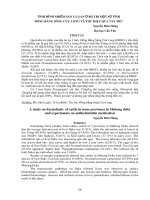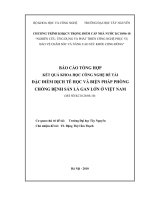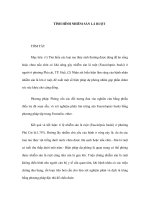Cập nhật tình hình nhiễm SÁN LÁ GAN LỚN tại Việt Nam Update Fascioliasis in vietnam 2020
Bạn đang xem bản rút gọn của tài liệu. Xem và tải ngay bản đầy đủ của tài liệu tại đây (1.23 MB, 22 trang )
FASCIOLIASIS SITUATION IN VIETNAM
Do Trung Dung,
National Institute of Malariology, Parasitology and Entomology, Vietnam
OUTLINE
1. General information of Fascioliasis
2. Life cycle of fasciola
3. Symptoms of fasciola patients
4. Key rick factors
5. Key control activities
6. Key challenges
7. Next activities
2
Introduction of Fascioliasis
- Cause of Fascioliasis: Fasciola gigantica, Fasciola hepatica.
- F. hepatica: South American, Europe, Australia
- F. gigantica: Africa and Asia (WHO, 2017).
- The hybrid forms of F. hepatica and F. gigantica in Vietnam, Korea, Japan, China….
- 2017 WHO estimated 2.4 million people infected, 180 million people at risk in 70 countries.
3
Introduction of Fascioliasis in Vietnam
- Codvell and colleagues discovered F. gigantica in 1928.
- Nguyen Xuan Huyen found a case in 1959.
- Do Duong Thai announced 2 fasciola cases in 1978.
- 1997-2000, Tran Vinh Hien found 500 fasciola cases in Central and Southern Vietnam by ELISA.
- From 2002-now many cases were diagnosed and treated.
4
Life cycle of Fasciola spp.
5
Fasciola in snail
Lymnaea snail:
- 0.4% in Quang Nam (Lực, 2010).
- 0.6% in Quang Ngai (Hương, 2012)
- 0.1% in Ha Noi (Dung, 2013)
- 1.6% in Binh Dinh (Dung, 2013)
(Austropeplea viridis = L viridis, Radix auricularia = L. swinhoei Radix rubiginosa)
Lymnaea viridis
Rice fields in both plain &
highland
Lymnaea swinhoei
Small channel in plain
Fasciola in aquatic vegetable
- Coriandrum spp. (Rau mùi) : 0.5 metacercaria/kg (Luc, 2010)
- Ipomoea aquatica (Rau muống): 0.4 metacercaria/kg (Luc, 2010)
- Coriandrum spp. 1/100 of vegetable samples infect metacercaria (Đe, 2013).
Fasciola in animal (reservoir host)
- Livestock 35% in Viet Nam (review Hien, 2011)
- Goat 5.3-30.4% (Thanh, 1997-1999; Phan, 2002)
- Buffalo, cow 51.9% Mekong delta river (Hùng, 2011)
- Buffalo, cow 54.9% Binh Đinh (Thanh, 2011)
- Buffalo, cow 61.5% Quang Ngai (Hương, 2012)
- Livestock 72.2% (Dung, 2016)
- Buffalo, cow 41.3% Ha Noi (Lan Anh, 2017)
Human Reported Cases
Ha Giang
Cao Bang
Lao Cai
Lai Chau
Tuyen Quang
Son La
Bac Kan
Lang Son
Yen Bai
Dien Bien Phu
Thai Nguyen
Vinh Phuc
Phu Tho
Bac Giang
TP. Ha Noi
-
Hoa Binh
Ha Nam
Distribution
Ninh Binh
Thanh Hoa
Quang Ninh
Bac Ninh
Hai Duong
TP. Hai Phong
TP. Hai Phong
Thai Binh
Nam Dinh
Nghe An
In 51/63 provinces of Vietnam
Ha Tinh
Quang Binh
- Characteristics
Quang Tri
Thua Thien Hue
Da Nang
Number of fasciolasis cases
Quang Nam
+ Age: over 90% of patients are > 15 years old.
No patient
Quang Ngai
1-10 cases
Kon Tum
11-100 cases
+ Gender: 62% female.
Binh Dinh
101-200 cases
Gia Lai
>201 cases
Phu Yen
Dak Lak
Dak Nong
Binh Phuoc
Lam Dong
Tay Ninh
Binh Duong
Kien Giang
Dong Nai
Binh Thuan
TP.Ho Chi Minh
Long An
Ba Ria Vung Tau
An Giang
Dong Thap
Tien Giang
Vinh Long
Ben Tre
Can Tho
Kien Giang
Hau Giang
Tra Vinh
Soc Trang
Bac Lieu
Ca Mau
Khanh Hoa
Ninh Thuan
Number of Fasiola patients
Year
Northern provinces
Centre provinces
Southern provinces
Total (100%)
2012
701 (13.6%)
4,382 (85%)
72 (1.4%)
5,155
2013
599 (14%)
3,467 (81.2%)
204 (4.8%)
4,270
2014
1,024 (34.4%)
1,694 (56.6%)
276 (9.2%)
2,994
2015
724 (20.6%)
1,912 (54.5%)
876 (25.0%)
3,512
2016
2,547 (55.9%)
1,780 (39.1%)
228 (5.0%)
4,555
2017
3,126 (26,4%)
7,880 (66.5%)
852 (7,1%)
11,858
2018
2,308
10,413
NA
> 12.000
2019
4,107
NA
NA
-
2020
1,328
NA
NA
-
Source: NIMPE, IMPE QN, IMPE HCM, Provinces
The prevalence of fasciola in human in community
ID
Place of survey
Year
Prevalence
1
Đại Lộc - Quảng Nam
2010
5%
2
Phù Cát – Bình Định
2011
6%
3
Quảng Nam
2012
2.5%
4
Quảng Ngãi
2012
10.36%
5
Thanh Hố
2014
1.29%
6
Nghệ An
2014
0.38%
7
Bắc Giang
2014
0.19%
8
Hoa Bình
2014
0.1%
9
Bình Định
2018
4.8%
10
Phú n
2018
5.7%
Occupation characteristics of the hospitalized fascioliasis patients
Occupation
Yes.
%
75
36.4%
54
26.2%
14
6.8%
63
30.5%
(n = 206, Fascioloasis human cases)
Farmer
Official staffs
Students
Free job
Source: Tho, 2018
12
Clinical symptoms on hospitalized patients
#
Clinical symptoms
n = 206
%
1
Upper abdominal pain
148
71.9%
2
Fever
21
10.2%
3
Periumbilical pain
7
3.4%
4
Itching and skin rashes
7
3.4%
5
Weight lost
5
2.4%
6
Asymptomatic cases
18
8.7%
Source: Tho, 2018
13
Subclinical characteristics of the hospitalized fascioliasis patients
Laboratory findings
Yes
%
24
11.7%
204
99.0%
199
96.6%
4
1.9%
Increased eosinophile (> 7%)
195
94.7%
Increased GOT value (normal 3- 31 U/L)
30
14.6%
Increased GPT value (normal 3-33 U/L)
28
13.6%
(n = 206, Fascioloasis human cases)
Fasciola eggs in the faeces samples
Ab-ELISA
Liver parenchyma lesions
Anemia (Hb < 120 g/L)
14
Source: Tho, 2018
Ectopic infestation Fascioliasis
Some fasciola ectopic infestation occur on knee, chest, abdominal wall
F. gigantica
F. hepatica
Key risk factors in Vietnam
- The reservoir host (buffalo, cow, sheep, goat..) high infection with fasciola in community.
- The wastewater is directly used as agricultural water to culture aquatic plants without treatment.
- Traditionally high consumption of raw aquatic plants.
Key control activities in Vietnam
1) Develop guideline for fascioliasis diagnosis and treatment; distributed the guideline to provinces.
2) Training for health staffs at district & provincial level on fascioliasis diagnosis and
treatment.
3) IEC activities for prevention of fascioliasis at community.
Outcome of control activities in Vietnam
Increased awareness of people about fascioliasis;
Most of the hospitals at province and district level have ultrasound and many can diagnose fascioliasis;
130,000 tablets of triclabendazole were donated by Novatis through WHO to hospitals in Vietnam since 2004.
More and more fascioliasis patients were treated.
Key challenges in Vietnam?
Current control activities are mainly on "treatment“.
“Transmission control“ needs to be strengthened.
How can we block transmission ?
Treatment of
Fascioliasis
agricultural water/
wastewater
Stop eating
raw vegetables
Deworming for animals,
Faeces control
Next plan for Fascioliasis control
- More fasciola patients are receiving treatment but we need reduction of costs of hospitalisation
(Improved diagnosis and treatment process).
- Need further collaboration with veterinary sector for deworming for animals and treatment water
- Health education to avoid eating raw vegetables.
THANK YOU FOR YOUR ATTENTION!









